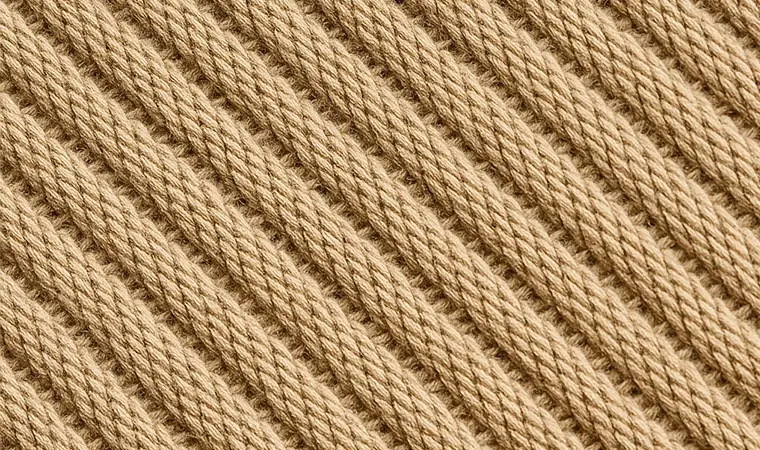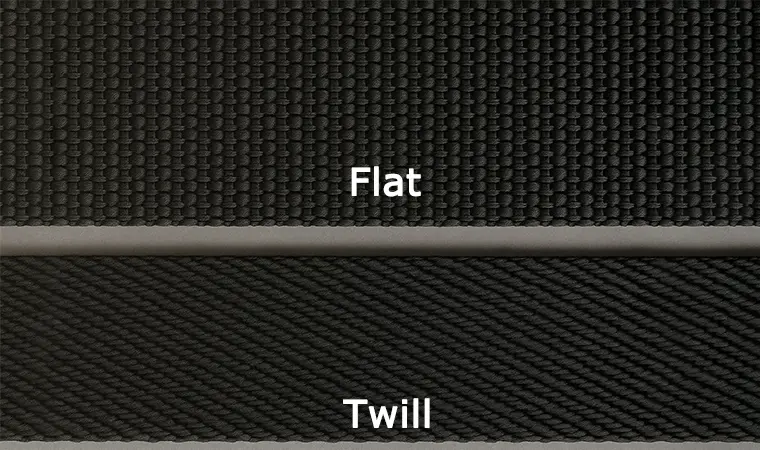When sourcing webbing for your product, you likely focus on material (like polyester vs. nylon) and breaking strength. But there's a critical, often overlooked detail that significantly impacts performance, feel, and durability: the weave pattern. The way the yarns are interlaced determines more than just the webbing's appearance; it defines its core characteristics.
As a webbing manufacturer with over 20 years of experience, we've seen how choosing the wrong weave can lead to premature wear, aesthetic mismatches, or even product failure. This guide will demystify the two most common patterns—Plain Weave and Twill Weave—to help you make an informed decision that protects your product's quality and your brand's reputation.
The Foundation: What is Plain Weave Webbing?
Plain weave is the most fundamental and common webbing pattern. It's created by a simple one-over, one-under interlacing of warp (lengthwise) and weft (crosswise) yarns. Think of a simple checkerboard or a basket weave—that's the structure. This simplicity creates a stable, predictable, and highly versatile fabric.

Key Characteristics of Plain Weave:
- High Stability: The tight, frequent interlacing of yarns prevents them from shifting, resulting in a very stable strap that resists stretching and distortion.
- Smooth, Flat Surface: It provides an ideal canvas for printing. If you're considering custom branding, our guide on Jacquard vs. Printed Webbing can help you decide if this is the right path.
- Cost-Effective: The straightforward weaving process makes it one of the most economical options to produce.
- Good All-Around Strength: While not the absolute strongest in every metric, it offers excellent and reliable tensile strength for its weight.
Best Applications for Plain Weave Webbing:
Plain weave is the go-to choice for general-purpose applications where stability and cost are key drivers. You'll find it in everyday products like backpack straps, basic pet leashes, luggage straps, and utility tie-downs. Its reliable performance makes it a staple in our Polypropylene and standard Polyester Webbing lines.
The Workhorse: What is Twill Weave Webbing?
Twill weave is easily identified by its distinct diagonal lines or "wales" on the surface. This pattern is created by passing the weft yarn over two or more warp yarns and then under one or more, with an offset on each successive row. This construction is what gives denim its classic look.

Key Characteristics of Twill Weave:
- Superior Abrasion Resistance: This is the standout feature. With fewer interlacing points, the yarns "float" over the surface for longer stretches. This means the webbing can better withstand rubbing and friction without snagging or fraying.
- Pliable and Flexible: The looser construction allows the webbing to drape and flex more easily than a rigid plain weave, making it feel softer and more comfortable.
- Higher Strength-to-Weight Ratio: The construction allows for a denser pack of yarns, often resulting in higher tensile strength compared to a plain weave of the same thickness.
- Hides Soil: The uneven surface and texture can help mask minor dirt and stains, a useful feature for outdoor and tactical gear.
Best Applications for Twill Weave Webbing:
Twill weave is the undisputed champion for heavy-duty and high-wear applications. Its durability makes it the standard for military and tactical gear, including PALS/MOLLE systems and rifle slings. You'll also find it in high-end outdoor equipment, cargo straps, and safety harnesses where abrasion resistance is critical. Many of our Mil-Spec webbing products, like those conforming to MIL-W-17337 standards, utilize a twill weave for this very reason.
Plain Weave vs. Twill Weave: A Head-to-Head Comparison
To help you decide, here’s a direct comparison based on the factors most important to product designers and B2B buyers:
| Feature | Plain Weave | Twill Weave |
|---|---|---|
| Appearance | Flat, matte, checkerboard pattern | Distinct diagonal lines, slightly textured |
| Abrasion Resistance | Good | Excellent. The best choice for high-friction environments. |
| Flexibility & Drape | Stiffer, more rigid | Softer, more pliable, and drapes better. |
| Suitability for Printing | Excellent. Smooth surface is ideal for clear prints. | Fair. The diagonal texture can distort fine details. |
| Cost | More economical due to simpler manufacturing. | Slightly higher cost due to a more complex weave. |
| Common Use Cases | General utility straps, bag handles, light-duty tie-downs. | Tactical gear, safety harnesses, cargo straps, pet harnesses. |
Beyond the Basics: Other Weaves to Know
While Plain and Twill are the most common, you may encounter other variations:
- Herringbone: A variation of twill that creates a distinctive "V" or broken zigzag pattern. It offers similar durability and flexibility to twill but with a more decorative look, making it popular for fashion belts and bag straps made from materials like Cotton Webbing.
- Tubular Weave: This isn't a surface pattern but a construction method that creates a hollow, flattened tube. As we explain in our Flat vs. Tubular Webbing guide, this design is exceptionally strong and has soft, rounded edges, making it the top choice for climbing and safety applications where cutting into the user or a rope is a concern.
The Manufacturer's Verdict: The choice between plain and twill weave is a classic trade-off between cost-effectiveness and specialized performance. For 80% of general applications, a plain weave offers the perfect balance of strength and value. But for any product that will be dragged, rubbed, or relied upon in a critical safety or tactical situation, investing in the superior abrasion resistance of a twill weave is a non-negotiable part of quality design.
Understanding the nuances of webbing construction is key to sourcing the right component. It ensures your final product not only looks the part but performs flawlessly for its entire intended lifecycle. If you're unsure which weave pattern is best suited for your specific needs, our experts are here to help. We can provide samples and technical guidance to ensure you get the perfect webbing for your application.
Contact TMG Webbing today to discuss your project and request a sample.

